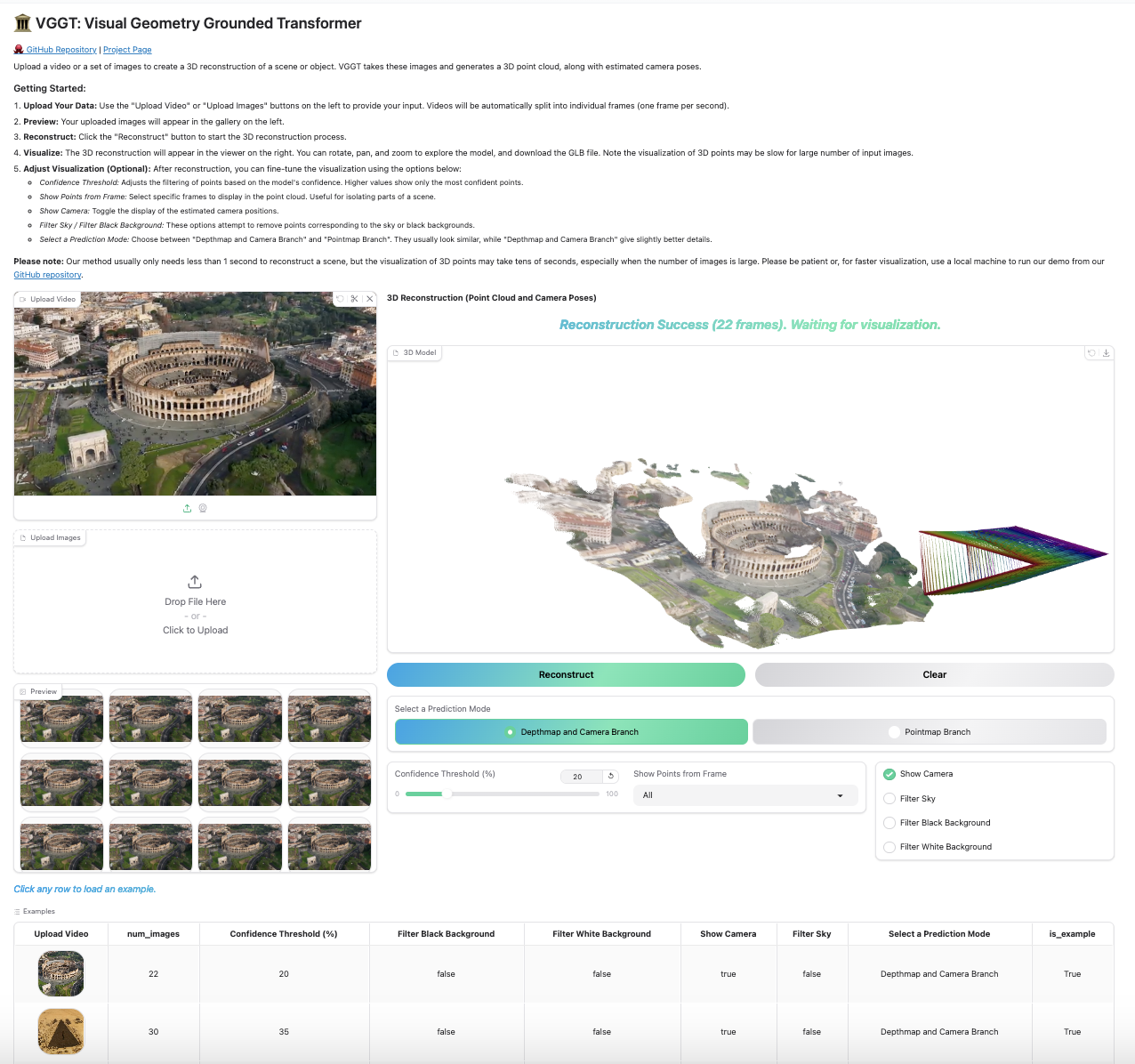@inproceedings{wang2025vggt,
title={VGGT: Visual Geometry Grounded Transformer},
author={Wang, Jianyuan and Chen, Minghao and Karaev, Nikita and Vedaldi, Andrea and Rupprecht, Christian and Novotny, David},
booktitle={Proceedings of the IEEE/CVF Conference on Computer Vision and Pattern Recognition},
year={2025}
}Visual Geometry Grounded Transformer (VGGT, CVPR 2025) is a feed-forward neural network that directly infers all key 3D attributes of a scene, including extrinsic and intrinsic camera parameters, point maps, depth maps, and 3D point tracks, from one, a few, or hundreds of its views, within seconds.
First, clone this repository to your local machine, and install the dependencies (torch, torchvision, numpy, Pillow, and huggingface_hub).
git clone [email protected]:facebookresearch/vggt.git
cd vggt
pip install -r requirements.txtAlternatively, you can install VGGT as a package (click here for details).
Now, try the model with just a few lines of code:
import torch
from vggt.models.vggt import VGGT
from vggt.utils.load_fn import load_and_preprocess_images
device = "cuda" if torch.cuda.is_available() else "cpu"
# bfloat16 is supported on Ampere GPUs (Compute Capability 8.0+)
dtype = torch.bfloat16 if torch.cuda.get_device_capability()[0] >= 8 else torch.float16
# Initialize the model and load the pretrained weights.
# This will automatically download the model weights the first time it's run, which may take a while.
model = VGGT.from_pretrained("facebook/VGGT-1B").to(device)
# Load and preprocess example images (replace with your own image paths)
image_names = ["path/to/imageA.png", "path/to/imageB.png", "path/to/imageC.png"]
images = load_and_preprocess_images(image_names).to(device)
with torch.no_grad():
with torch.cuda.amp.autocast(dtype=dtype):
# Predict attributes including cameras, depth maps, and point maps.
predictions = model(images)The model weights will be automatically downloaded from Hugging Face. If you encounter issues such as slow loading, you can manually download them here and load, or:
model = VGGT()
_URL = "https://huggingface.co/facebook/VGGT-1B/resolve/main/model.pt"
model.load_state_dict(torch.hub.load_state_dict_from_url(_URL))You can also optionally choose which attributes (branches) to predict, as shown below. This achieves the same result as the example above. This example uses a batch size of 1 (processing a single scene), but it naturally works for multiple scenes.
from vggt.utils.pose_enc import pose_encoding_to_extri_intri
from vggt.utils.geometry import unproject_depth_map_to_point_map
with torch.no_grad():
with torch.cuda.amp.autocast(dtype=dtype):
images = images[None] # add batch dimension
aggregated_tokens_list, ps_idx = model.aggregator(images)
# Predict Cameras
pose_enc = model.camera_head(aggregated_tokens_list)[-1]
# Extrinsic and intrinsic matrices, following OpenCV convention (camera from world)
extrinsic, intrinsic = pose_encoding_to_extri_intri(pose_enc, images.shape[-2:])
# Predict Depth Maps
depth_map, depth_conf = model.depth_head(aggregated_tokens_list, images, ps_idx)
# Predict Point Maps
point_map, point_conf = model.point_head(aggregated_tokens_list, images, ps_idx)
# Construct 3D Points from Depth Maps and Cameras
# which usually leads to more accurate 3D points than point map branch
point_map_by_unprojection = unproject_depth_map_to_point_map(depth_map.squeeze(0),
extrinsic.squeeze(0),
intrinsic.squeeze(0))
# Predict Tracks
# choose your own points to track, with shape (N, 2) for one scene
query_points = torch.FloatTensor([[100.0, 200.0],
[60.72, 259.94]]).to(device)
track_list, vis_score, conf_score = model.track_head(aggregated_tokens_list, images, ps_idx, query_points=query_points[None])Furthermore, if certain pixels in the input frames are unwanted (e.g., reflective surfaces, sky, or water), you can simply mask them by setting the corresponding pixel values to 0 or 1. Precise segmentation masks aren't necessary - simple bounding box masks work effectively (check this issue for an example).
We provide multiple ways to visualize your 3D reconstructions and tracking results. Before using these visualization tools, install the required dependencies:
pip install -r requirements_demo.txtPlease note: VGGT typically reconstructs a scene in less than 1 second. However, visualizing 3D points may take tens of seconds due to third-party rendering, independent of VGGT's processing time. The visualization is slow especially when the number of images is large.
Our Gradio-based interface allows you to upload images/videos, run reconstruction, and interactively explore the 3D scene in your browser. You can launch this in your local machine or try it on Hugging Face.
Run the following command to run reconstruction and visualize the point clouds in viser. Note this script requires a path to a folder containing images. It assumes only image files under the folder. You can set --use_point_map to use the point cloud from the point map branch, instead of the depth-based point cloud.
python demo_viser.py --image_folder path/to/your/images/folderTo visualize point tracks across multiple images:
from vggt.utils.visual_track import visualize_tracks_on_images
track = track_list[-1]
visualize_tracks_on_images(images, track, (conf_score>0.2) & (vis_score>0.2), out_dir="track_visuals")This plots the tracks on the images and saves them to the specified output directory.
Our model shows surprisingly good performance on single-view reconstruction, although it was never trained for this task. The model does not need to duplicate the single-view image to a pair, instead, it can directly infer the 3D structure from the tokens of the single view image. Feel free to try it with our demos above, which naturally works for single-view reconstruction.
We did not quantitatively test monocular depth estimation performance ourselves, but @kabouzeid generously provided a comparison of VGGT to recent methods here. VGGT shows competitive or better results compared to state-of-the-art monocular approaches such as DepthAnything v2 or MoGe, despite never being explicitly trained for single-view tasks.
We benchmark the runtime and GPU memory usage of VGGT's aggregator on a single NVIDIA H100 GPU across various input sizes.
| Input Frames | 1 | 2 | 4 | 8 | 10 | 20 | 50 | 100 | 200 |
|---|---|---|---|---|---|---|---|---|---|
| Time (s) | 0.04 | 0.05 | 0.07 | 0.11 | 0.14 | 0.31 | 1.04 | 3.12 | 8.75 |
| Memory (GB) | 1.88 | 2.07 | 2.45 | 3.23 | 3.63 | 5.58 | 11.41 | 21.15 | 40.63 |
Note that these results were obtained using Flash Attention 3, which is faster than the default Flash Attention 2 implementation while maintaining almost the same memory usage. Feel free to compile Flash Attention 3 from source to get better performance.
Our work builds upon a series of previous research projects. If you're interested in understanding how our research evolved, check out our previous works:
Thanks to these great repositories: PoseDiffusion, VGGSfM, CoTracker, DINOv2, Dust3r, Moge, PyTorch3D, Sky Segmentation, Depth Anything V2, Metric3D and many other inspiring works in the community.
See the LICENSE file for details about the license under which this code is made available.
